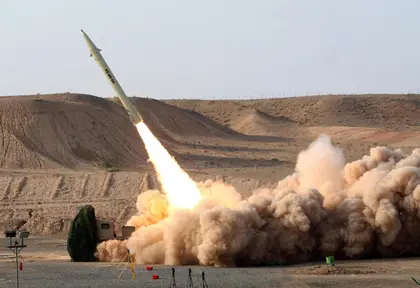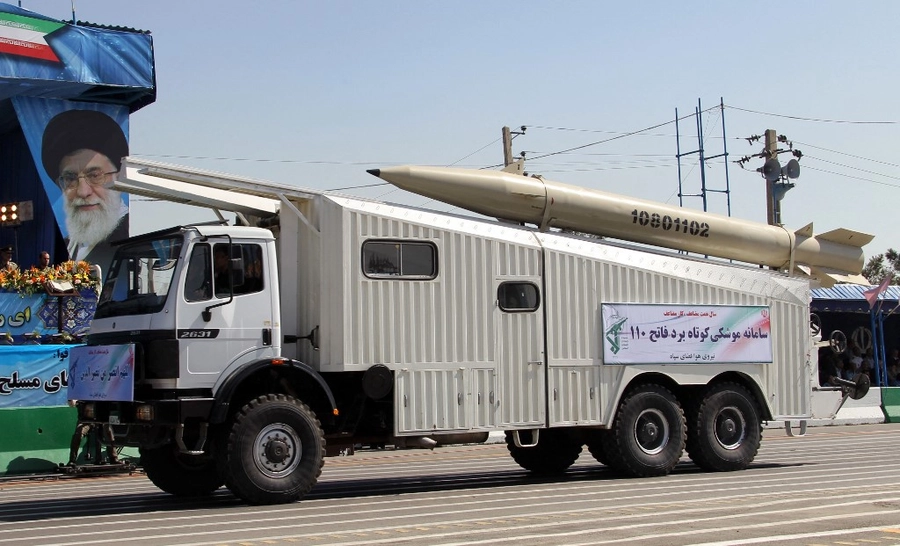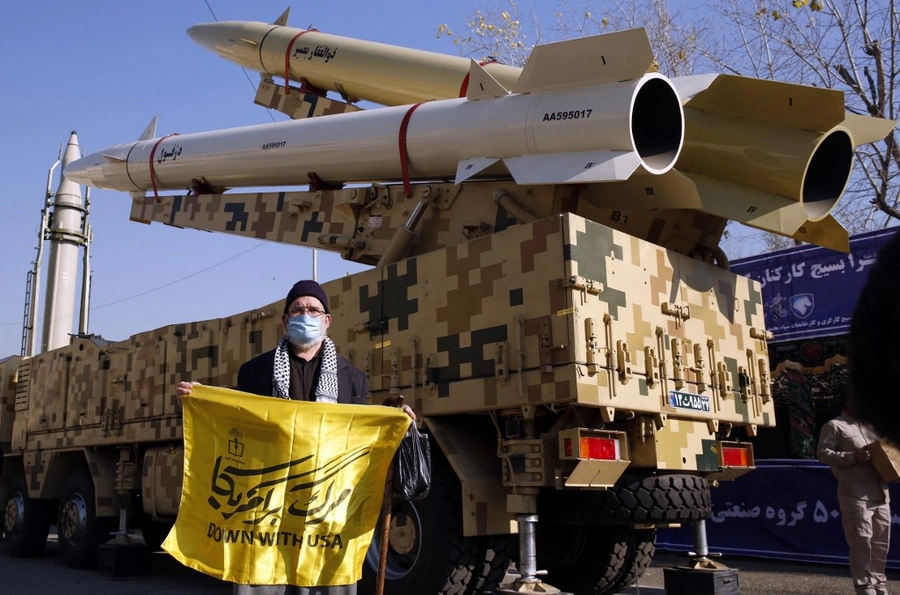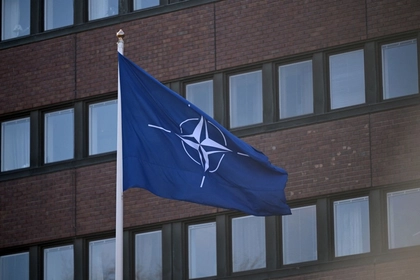Russia and Iran are trying to strike a deal on the transfer of ballistic missiles from Teheran to Moscow. So far, however, any such deal has been hampered by a UN Security Council Resolution (UNSCR) that endorsed an embargo on Iran’s missile technology in place since 2015.
According to the UNSCR, the missile embargo is set to terminate on Oct. 18, 2023. Thereafter, Tehran will be allowed to export missiles and related technologies without international control, and Russia will be able to get missiles from Iran for its war against Ukraine.
JOIN US ON TELEGRAM
Follow our coverage of the war on the @Kyivpost_official.
Which missiles are we talking about?
Russia is interested in two models of Iranian ballistic missiles, the Fateh-110 and the Zolfaghar. The Fateh-110 is capable of attacking targets at a distance of 300 kilometers, while the Zolfaghar can reach targets up to 700 kilometers.
The Fateh-110 is an Iranian ballistic surface-to-surface missile. Its flight speed reaches Mach 4, the mass of explosives in the warhead is 650 kilograms.
For comparison, the Russian Iskander ballistic missile has a warhead weighing 480 kilograms. The missile has been used in Syria by both Iran’s Islamic Revolutionary Guard Corps (IRGC) and Hezbollah forces.
The serial production of these missiles began back in 2002, but since then Iran has continued to modernize them. The Fateh-110 initial model had a limited flight range of 200 kilometers.
However, over the years of development and modernization, the latest fourth-generation Fateh-110 is capable of striking at a distance of up to 300 kilometers.

Russia, China FMs Meet as ASEAN Talks Get Underway in Laos
In addition, over the years, the accuracy of the missiles has improved: the declared deflection from the target is 3 meters. However, these are Iranian data, which may be exaggerated.
A military truck parades the surface-to-surface Fateh 110 during an annual military parade which marks Iran's eight-year war with Iraq, in the capital Tehran on September 22, 2010. PHOTO: AFP.
The development of Fateh-110
The Fateh-110 was created on the basis of the unguided Iranian missile Zelzal-2, which, in turn, was based on Zelzal-1, one of the first successful missiles in the Iranian program.
The Iranian Zelzal-1 was based on the Chinese CSS-8 missile, which the country exported to Iran in 1989-1992. CSS-8 missiles (Project 8610), in fact, were a modified version of the Soviet S-75. The Chinese modification simply turned the air defense missile into a tactical surface-to-surface ballistic missile.
The Soviet tactical unguided missile 9K52 Luna-M also significantly influenced the development of Zelzal-1. As such, Iran’s missile program was the result of a combination of Soviet and Chinese technology refined over time.
The Zolfaghar missile is an improved version of the Fateh-110. Even visually, Zolfaghar looks like an enlarged Fateh-110. Larger dimensions are necessary to increase the volume of fuel and extend the flight range to 700 kilometers. The mass of the Zolfaghar warhead is 580 kilograms.
What is the danger?
The main problem is that Fateh-110 and Zolfaghar are ballistic missiles rather than cruise missiles so they are hard to intercept and shoot down.
Ballistic missiles fly along a trajectory that is difficult for air defense systems. First, they rise to a height of 40 to 50 kilometers, and then fly vertically downward, directly onto the target. It is also worth considering that these missiles are very fast, up to Mach 4, which is about 4,900 kilometers per hour.
With such characteristics, the Iranian Fateh-110 can cover a distance of 300 kilometers in just 5 minutes.
If Russia does receive Fateh-110 missiles, this will mean that the Russians will have the potential for strikes almost anywhere in Ukraine, with the exception of the southwestern regions. At the same time, the entire territory of Ukraine can be attacked with Zolfaghar missiles, which have a range of 700 kilometers.
The only effective way to neutralize a ballistic missile is to intercept it with the help of an anti-missile defense system. To counter such threats, Ukraine needs air defense systems similar to the US-based Patriot.
German Chancellor Olaf Scholz announced that Berlin would be providing Ukraine with additional Patriot complexes to improve its air defense system this winter.
An Iranian man holds an anti-US sign next to Zolfaghar-Basir and Dezful missiles displayed at Mosallah mosque. PHOTO: AFP
Why would a missile deal be beneficial to Russia and Iran?
A warning about the possibility of Iran exporting short-range and operational-tactical ballistic missiles to Russia was sounded as early as the fall of 2022.
In the international classification system, short-range ballistic missiles can fly at a distance of 500 to 1,000 kilometers. Missiles with a range of less than 500 kilometers are considered operational-tactical.
Ukraine is already feeling the consequences of close cooperation between Russia and Iran – in particular, an increase in the supply of attack and surveillance drones.
On Oct. 8, Yuriy Ihnat, spokesman for the Ukrainian Air Force reported that “there could be a record number of Russian kamikaze drone strikes against Ukraine this autumn and winter.”
According to Ihnat, in September 2023 alone the occupiers used more than 500 attack drones. In the previous year, such quantity was used in three months.
“For the six months of the last heating season, more than 1,000 Shahed drones were fired against Ukraine,” he said. “Now we have 500 attacks in just one month.”
Until 2019, production of short-range ballistic missiles in Russia was restricted under the Intermediate-Range Nuclear Forces Treaty signed by the United States and the Soviet Union in 1988. Therefore, Russia could not accumulate a significant arsenal of these missiles before the start of the war with Ukraine.
In the context of Iranian missiles, Russia is interested in the same thing as in the case of drones. Above all, their quantity, not quality, is important for them. Russia does not even attach much importance to the dubious accuracy of these missiles, as the issue of hitting civilians hasn’t seemed to concern the Russian military command.
In terms of operational-tactical missiles, the Russian command did not foresee such a duration of the conflict – so they did not prepare for it. The Russians are still producing missiles for Iskander complexes. However, it seems that the number of these missiles is not sufficient, since they use them quite sparingly.
For its part, Iran can also benefit significantly from the supply of ballistic missiles to Russia. The country has always been interested in Russian fourth-generation Su-35 fighters and S-400 air defense systems.
In addition, Iran seeks to obtain samples of Western weapons that Russia has managed to capture in Ukraine.
You can also highlight the text and press Ctrl + Enter








